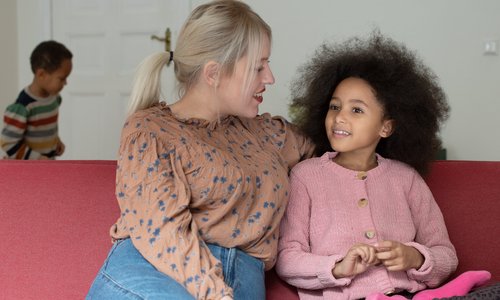
Sexual abuse of minors by adults does not happen by accident, but is usually a planned act. Accordingly, prevention also needs a plan: a prevention concept in order to ensure that perpetrators have no room for abuse. A prevention concept should include advanced training for all professionals, a facility-specific plan of action or emergency plan as well as providing prevention for children and adolescents and their legal guardians.
What are prevention concepts?
Prevention concepts help organisations and facilities in the education, health and social sectors, such as day-care centres, schools, sports clubs or even doctors' practices to become places where children and adolescents are protected from sexual violence.
They reduce the risk of sexual violence being perpetrated in an institution or within an organisation and help to ensure that targeted children and adolescents are identified by professionals and have access to help.
Institutional prevention concepts for preventing and intervening are interactions between analysis, structural changes, agreements and communications as well as the attitude and culture of an organisation. The "No room for abuse" and "School against sexual violence" initiatives provide in-depth orientation options for developing prevention concepts. They are based on the guidelines issued by the Round Table for “Child Sexual Abuse”.
How can prevention concepts be developed?
Developing and implementing prevention concepts is the responsibility of the management of an institution and its institutional provider. A participatory process that simultaneously relies on the motivation and participation of the employees is needed so that the analyses, decisions and agreements are supported, implemented and lived by all.
Depending on how it is used, the possibilities of participation by children, adolescents and their guardians should also be utilised so that the prevention concept can then take these specific perspectives into consideration. Support from a counselling centre against sexualised violence or external experts from the relevant sector will also be needed for the prevention process to succeed. Competent external support in developing a prevention concept will help to identify possible patterns and dynamics within the institution that should always be taken into consideration in a prevention concept.
Risk and potential analyses are the basis
A risk analysis systematically pursues two questions: Which on-site conditions could perpetrators exploit? And: can targeted children or adolescents find on-site contacts who are also aware and will provide them with good conversations, listen to them and help them?
The assessments, ideas and experiences of girls and boys are indispensable, especially as part of a risk analysis.
A potential analysis asks what preventive structures or measures are already in place on which the prevention concept can be based, i.e. with regard to addiction, bullying or violence issues.
If cases of past sexual violence have already become known, then a review of the incidents should be included in the risk analysis so that possible weak points within the institution can be excluded in the future.
The results from this analysis should show which conceptual and structural improvements are still needed in the facility in terms of child protection.
What are the prevention concepts components?
Child protection, and thus also explicit protection from sexual violence, should have top priority in institutions and organisations that work with minors. This should be made clear in the articles, ethics policy or general principle of an institution or organisation.
The code of conduct is an important prevention tool and it provides guidance to staff on how to deal with girls and boys in a way that observes and respects boundaries. A code of conduct formulates rules for situations that could be exploited by an institution’s staff for sexual violence. In a best case scenario, setting such rules and prohibitions together as a team makes it more difficult to initiate sexual abuse and at the same time it protects the staff from false suspicions.
Similar objectives are pursued by signing a so-called declaration of commitment.
The level of knowledge about sexual violence should be expanded through the qualification of all full-time and voluntary staff that work with children and adolescents and kept up-to-date through advanced training. Only with sufficient knowledge will it be possible to penetrate the relevance of the issue, to develop awareness and to be able to act appropriately in the event of speculation and suspicion.
Personnel responsibility begins with child protection awareness when recruiting personnel. A variety of measures that are permitted under data protection law that go beyond the important inspection of the extended certificate of good conduct can also be used.
For example, child protection is an issue that should be included in the job interview and questions that are permitted about any relevant convictions or ongoing investigations should always be asked. Job references should be read with a specific child protection bias (and even formulated in this way by the institution).
However, the prevention issue should always remain a discussion topic after recruitment. Management should always provide time for exchanges, questions and suggestions during team meetings and staff discussions. Personnel responsibility also includes monitoring the standards set in everyday work with a critical and constructive eye and, if necessary, addressing staff members proactivley. This is especially important if dealing professionally with children and adolescents with regard to closeness and distance appears to be problematic for any staff members or if agreements in the code of conduct are not being adhered to.
Moving towards systematic participation of children and adolescents in decisions that will affect them will bolster their position and reduce the power imbalance between adults and minors. Participation-oriented organisations and institutions make accessing children's rights easier and it also makes children and adolescents able to criticise when they have cause for complaint. Formal co-determination committees, such as home councils or pupil representatives, are also important, because the positive experience with these formats can authentically convey to children and young people that they are actually being listened to and have an effect on shaping the life of the institution.
For children and adolescents, prevention offers included as part of the protection concepts will mean that children's rights are communicated and age-appropriate information about sexual violence and offers of help will be provided.
Educational and training institutions need sexual education and media education concepts as well as prevention and information services for parents and other caregivers.
Institutions and organisations need complaint structures that children and adolescents can use at low threshold levels. Complaint structures are a sign of awareness that children and adolescents can be confronted with all kinds of problems that can be solved with help from adults. It is irrelevant whether the cause of the problem lies inside or outside the institution.
For responsible managers, functioning complaint procedures mean more certainty that they will be informed early on about problematic processes, grievances or misconduct by staff members and they can then act accordingly. Specific contacts should be also appointed both inside and outside the facility to deal with the sexual violence issue in addition to the general complaint structures.
A contingency plan is a written procedure that is oriented towards the specific conditions in an institution and it is used when there is a suspicion of sexual abuse. A contingency plan sets out the necessary steps and responsibilities for evaluating suspicions of sexual violence inside and outside the facility. It is a "signpost" for prudence and at the same time it lists effective action with regard to child protection and it should always include a rehabilitation procedure if it turns out that a suspicion was unfounded.
Furthermore, the contingency plan formulates the obligation to deal with cases of sexual violence so that any conditions or wrong decisions that made the abuse possible can be analysed and preventive measures can then be developed for the future.
The contingency plan should also contain an obligation to involve experts, such as the institution's own child protection professionals or staff from specialised counselling centres, in assessing and making decisions about taking further action in (suspected) cases of sexual violence. In this way, wrong decisions and a procedure that puts the reputation of the institution above the best interests of the child can be prevented. Networking with external experts, even beyond acute cases, is also important for developing protection concepts and for quality developments in child protection.
Information about online prevention concepts can be found here.





